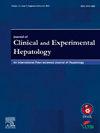Infantile Onset Budd Chiari Syndrome: Challenges and Outcome of Liver Transplantation After Radiological Interventions
IF 3.2
Q2 GASTROENTEROLOGY & HEPATOLOGY
Journal of Clinical and Experimental Hepatology
Pub Date : 2025-05-14
DOI:10.1016/j.jceh.2025.102589
引用次数: 0
Abstract
Introduction
Budd-Chiari syndrome (BCS) in infants is rare, and there is limited published literature on liver transplantation (LT).
Methods
Eight children who underwent LT for BCS from 2017 to 2023 were analyzed.
Results
Seven out of the eight children had radiological intervention (RI) prior to LT (3 had transjugular intrahepatic portosystemic shunt [TIPSS], and 4 had hepatic vein venoplasty). Hepatopulmonary syndrome (HPS) was seen post-TIPSS in 3 and postvenoplasty in 2 children, respectively. The indication for LT was refractory ascites or recurrent upper gastrointestinal bleed in 3 patients, HPS in 5 patients, respectively. The median age and weight of children at transplant was 51 months (IQR 26–82 months) and 11.35 kg (IQR 10.05–18 kg), respectively. The median duration from onset of symptoms to LT was 42 months (IQR 18.5–75 months). HPS resolved in the 4 patients alive, after a median period of 25 days (IQR 15.5–60 days). The median duration of post-transplant follow-up is 4 years 9 months (IQR 3 year 5 months–4 years 11 months). Vascular complications were seen in 37.5% patients which were amenable to RI. Biliary complications were seen in 25% of children. The 1-year and 3-year survival rates both were 75%.
Conclusion
BCS in infants can be managed effectively with RI followed by LT. LT has shown good long-term outcomes in children with BCS. HPS seems to be common after TIPSS in pediatric BCS. Recurrent BCS post-LT can be salvaged using RI. High biliary and vascular complications are likely related to HPS and previous TIPSS/RI.

婴儿起病Budd - Chiari综合征:放射干预后肝移植的挑战和结果
婴儿budd - chiari综合征(BCS)是罕见的,并且关于肝移植(LT)的已发表文献有限。方法分析2017 - 2023年8例BCS患儿行肝移植的临床资料。结果8例患儿中有7例在肝移植前接受了放射干预(RI),其中3例接受了经颈静脉肝内门静脉分流术(TIPSS), 4例接受了肝静脉成形术。肝肺综合征(HPS)分别出现在3例tipss后和2例静脉成形术后。LT的适应症为难治性腹水3例,复发性上消化道出血5例,HPS 5例。移植患儿的中位年龄和体重分别为51个月(IQR 26-82个月)和11.35 kg (IQR 10.05-18 kg)。从出现症状到LT的中位持续时间为42个月(IQR 18.5-75个月)。在存活的4例患者中,HPS在平均25天(IQR 15.5-60天)后消退。移植后随访的中位时间为4年9个月(IQR为3年5个月- 4年11个月)。血管并发症发生率为37.5%。25%的儿童出现胆道并发症。1年和3年生存率均为75%。结论对婴儿BCS进行RI后再进行LT治疗是有效的,LT治疗BCS患儿具有良好的远期疗效。小儿BCS患者在TIPSS后出现HPS似乎很常见。肝移植后复发性BCS可用RI抢救。高胆管和血管并发症可能与HPS和先前的TIPSS/RI有关。
本文章由计算机程序翻译,如有差异,请以英文原文为准。
求助全文
约1分钟内获得全文
求助全文
来源期刊

Journal of Clinical and Experimental Hepatology
GASTROENTEROLOGY & HEPATOLOGY-
CiteScore
4.90
自引率
16.70%
发文量
537
审稿时长
64 days
 求助内容:
求助内容: 应助结果提醒方式:
应助结果提醒方式:


